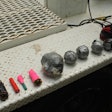At least seven major Mexican Drug Trafficking Organizations (DTOs) are primarily responsible for the $39 billion drug trade that floods narcotics across the U.S.-Mexico border. These opportunistic cartels form loose alliances that are only as strong as the narcotics proceeds fueling them. The DEA refers to several as "poly drug" organizations because they traffic cocaine, marijuana, heroin, and meth.
Here's a guide to the most active, and largest, cartels:
Mexican Federation (Sinaloa Cartel): The Sinaloa Federation, which is also known as the Pacific Cartel or Golden Triangle Alliance, was formed in the 1970s by Mexico's four major crime syndicates. By the 1990s, the cartel had grown to the size of the Colombian Medellin Cartel in its heyday and, in 2008, apparently split into several warring factions, including the Beltran-Leyva Organization. The Federation directs a large-scale transportation network for various narcotics, including shipping multi-ton quantities of cocaine from South America. Joaquin "El Chapo" Guzman Loera has been leading the cartel since 1995.
Arellano-Felix Organization (Tijuana Cartel): Seven brothers and four sisters inherited the cartel from Miguel Angel Felix Gallardo, who was jailed in 1989 for the kidnapping and murder of DEA agent Enrique "Kike" Camerena Salazar, among other crimes. Earlier this year, current leaders Teodoro "El Teo" Garcia Simental, Raydel "El Muletas" Lopez Uriarte, and brother Manuel were arrested.
Carrillo-Fuentes DTO (Juarez Cartel): Since the early 1990s, this cartel has controlled the smuggling corridor from Juarez-El Paso southeast to Ojinaga, Chihuaha, using extreme violence and intimidation. After the death of founder Amado Carrillo Fuentes in a Mexican hospital as a result of botched plastic surgery, brother and current leader Vicente took over. The cartel has been battling the Sinaloa Cartel, and relies on the Barrio Azteca gang in El Paso, Dallas, and Austin to distribute cocaine.
Gulf Cartel: The cartel's primary areas of operation include Nuevo Laredo, Miguel Aleman, Reynosa, and Matamoros in the Mexican state of Tamaulipas. The poly drug Gulf Cartel also operates in Nuevo Leon and Michoacan and is the primary supplier of the Atlanta area.
Los Zetas Cartel: As the one-time enforcers for the Gulf Cartel, the paramilitary Zetas are one of the most powerful and violent cartels in Mexico. The cartel was formed when Gulf hired a small group of deserters from the Mexican Army Special Forces that may have received counter-insurgency training at Fort Benning, Ga. The group split off and created its own cartel in early 2010.
La Familia Michoacana Cartel: This unique cartel, which achieved the federal government's Kingpin Designation Act list in April 2009, began in 2004 as armed vigilantes who portrayed themselves as crime fighters, stating their goal of eradicating meth. The group's practice of placing poorly spelled notes near the decapitated heads of rivals (especially in Uruapan) is part of its propaganda campaign. The cartel exhibits religious tendencies and cult-like behavior, requiring members to join group prayer sessions and wear La Familia logos. The group now produces meth in hilly Michoacan and intelligence officials believe it pays millions a month in bribe money to politicians.
Beltran-Leyva Organization: In 2008, Arturo Beltran Leyva separated from the Sinaloa Cartel and now transports multi-ton quantities of cocaine and marijuana into Arizona, California, Illinois, New York, and Texas.
Related Article:



















